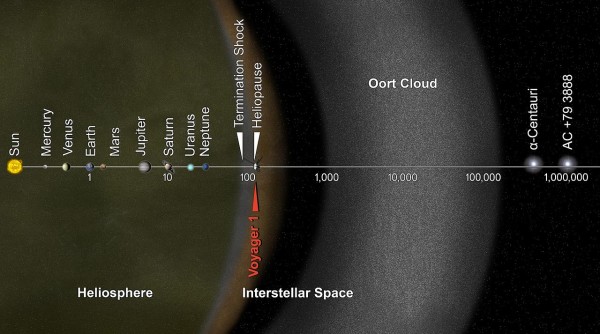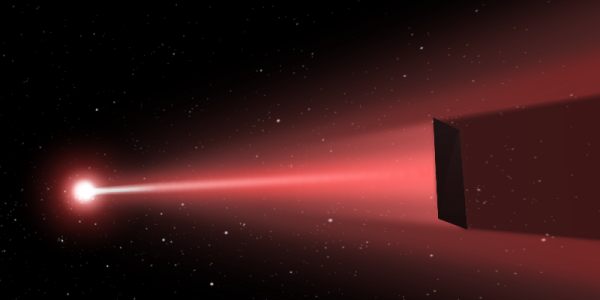"Fundamental physics is like an art more or less. It's completely non-practical, and you can't use it for anything. But it's about the universe and how the world came into being. It's very remote from your daily life and mine, and yet it defines us as human beings." -Yuri Milner
In one of the boldest initiatives ever announced, billionaire Yuri Milner and Stephen Hawking are working on developing a "Breakthrough Starshot" project, where an advanced laser array will power a sail-driven spacecraft to speeds exceeding 60,000 km/s, taking it to the nearest stars within a single human lifetime.
 A logarithmic chart of distances, showing the Voyager spacecraft, our Solar System and our nearest star, for comparison. Image credit: NASA / JPL-Caltech.
A logarithmic chart of distances, showing the Voyager spacecraft, our Solar System and our nearest star, for comparison. Image credit: NASA / JPL-Caltech.
It's an incredible ideas, and recent improvements in laser technology, strong-and-reflective materials and in electronics miniaturization seem to make this a realistic possibility. But there are a huge number of technical and scientific challenges ahead, and the pledged $100 million is barely a drop in the ocean of what's needed. This might be a legitimate possibility at long last, but the obstacles to overcome are tremendous.
 Image credit: the DEEP-laser sail concept, via http://www.deepspace.ucsb.edu/projects/directed-energy-interstellar-pre…, Copyright © 2016 UCSB Experimental Cosmology Group.
Image credit: the DEEP-laser sail concept, via http://www.deepspace.ucsb.edu/projects/directed-energy-interstellar-pre…, Copyright © 2016 UCSB Experimental Cosmology Group.

What's the mean free path of such probes relative to interstellar dust grains of micron size ?
At 50 million meters per second, a nanogram packs the punch of an artlillery shell
The interestellar medium is about 1 atom per litre.
You can work out the MFP of anything macroscopic in scale quite easily...
Could neutral hydrogen atoms be collected along the way and be put to use powering some form of transmitter?
It doesn't look like a great idea for the purpose they have. Beside anything else, they have no way to slow down when they get there.
But the idea of using lasers to boost craft has been around for a long time and if it's true that laser technology has passed some key threshold specific to the realization of that vision, then it's exciting none the less.
What could would be arranging a number of stand-alone laser enabled satelites in stationary position relative to one-another, sort of like aircraft runway lights but stretched out over a much larger distance.
With something like that we might accelerate craft in the precise direction they want to go, whereupon on arrival a similar 'runway' slows them down. That could work. Doesn't necessarily have to be vastly expensive, once everything is in place to manufacture and launch the stand-alone satelite's
I think that it's interesting that they're trying this 'hot air balloon' concept, but the main reason is that it is a good 'excuse' to invest in nano-tech research, and get the benefits out of that to use in future appliances. These guys are first and foremost businessmen, astronomy wise a trip to Jupiter would be far more interesting.
BTW wouldn't such a StarShot come to a halt 'halfway' when it nears the other star, as the sail gets to be pushed back by incoming rays of light; and the moment that it starts to turn just a little at such velocity it's gone. Overall it feels like a hoax with benefits. :)
To completely leave our universe behind breaking from the electronic connections that keeps our universe togather could be of some challenge,the energies within our universe do not support an outward flow, which will not help a laser beam energy on a long term.One fact is ,if an object could reach another star electronic connection that's mission accumplish. For us to successfully reach another star the plans has to be completely deferent, we need to start over with electricity ,learning about the minimal measurement and the action it support ,our body is dependent on electricity our five senses ,they are all a precise measure of electricity reporting to an electronic brain. If we understand the electronic connection between our planet , astroid and comets maybe,we could bring them into docking, load them up with cameras and set them on a mission to discovery. As for that laser beam space ship its communication cannot function without star energy, if ever it should leave the universe it should be over for that space ship ,the same goes for settie
The mythical black hole is big bucks, its understood why it is supported and fiercely defended by these black hole guru.Mr hakins successfully sold the world a mythical black hole and now he is asked to sell another, its not possible to leave our universe. If an object is leasered away from our universe and did not right then connect with another star it will return to sender.Proof of no black hole ,check out YOUTUBE SUNLIGHT ELECTRO RSYS doing what they said gravity should be doing, giving orbits to the earth and moon
That's nothing more than bollocks. Nobody is buying it, so why do you try?
I somehow feel SOL would be a better source of power than creating artificial means of far less light pressure to achieve the required outcome. Coherent light can be compressed into a narrow beam via several optical collimators in space to give greater energy to the sail. Any laser based generator would require far more input compared to its output (inefficiency) to get a similar result. Targetting the probe would be simplified by the fixed position and direction of all the elements; its path being the position of the planet in X amount of travel years (~22) according to the text at the required speed.
All the other issues are still present, though. How to apply course, attitude corrections, get status back from the payload to confirm any changes, slowing down for the approach, feedback tracking; the list goes on.......
What information is to be gathered upon arrival? Did the probe have a camera on board for visual information; a pinhole camera to keep the mass low, perhaps?
It would take 22 years to arrive there, then another 4.5 years before we receive a bitstream of data.
Hmmm, it's a great dream. No doubt we will benefit from nano technology in the meantime, so it is not a fruitless venture.
(I can't access Forbes; security settings on my computer.)
From estimates I've seen of the power requirements to do this (accelerate the objects quickly enough to get them up to speed in a distance at which the beam remains tight enough), it suggests that a commercial fusion reactor will be needed. If that's the case, and it becomes widely known, it'll be yet another incentive to keep fusion research on track and develop a working reactor ASAP.
Realistically, the trials to get the technology working, will get us various spinoffs that will be useful exploring our own system.
For example consider tiny probes, mesh-networked, that could drop through the atmosphere of Jupiter and send back data as they go, to other probes orbiting Jupiter that would in turn relay the data back to Earth. Or consider a flock of these things that could land on the more interesting moons of Jupiter and Saturn. Once you can build fast cheap objects, and fling them out into space, much becomes possible in terms of getting data we couldn't get otherwise.
On balance I'm inclined to consider this project aspirational rather than pragmatic. But the very fact that it keeps a public buzz going about interstellar exploration, will be worthwhile. In the end, that's where we're going.